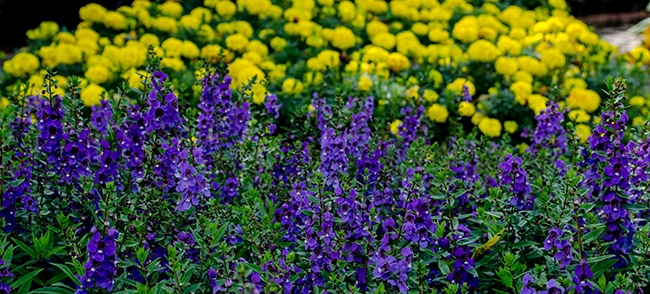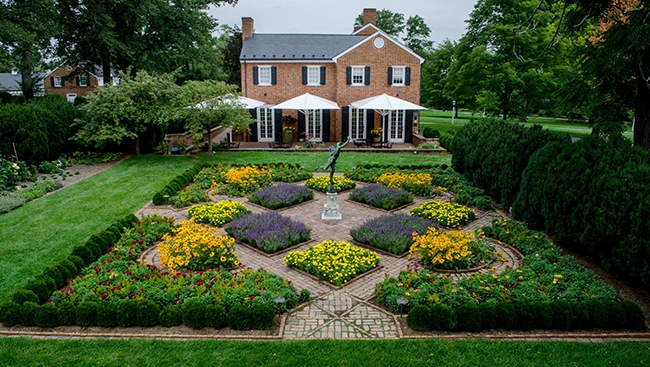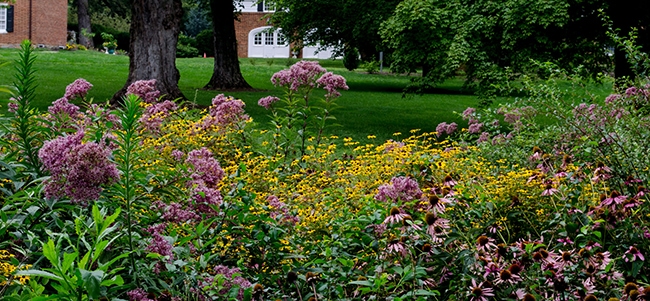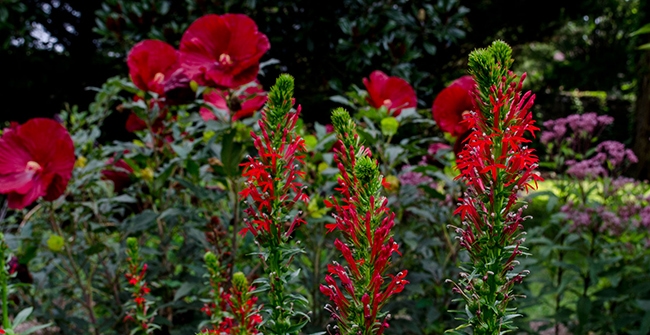A little planning—and a little weeding—can yield a colorful garden full of flowers and renew your enthusiasm for gardening during those hot dog days of summer.
The dog days of summer are not usually the favorite time of year for many gardeners. In spring, folks are itching to get outside. On a warm day in March, April or May, everyone is out marveling at the flushes of bloom filling a newly greening space. Each new flower is a cause for celebration as it emerges from its winter resting spot. It sure seems like gardening is a great hobby to start at this time of year.
In the early summer, that enthusiasm continues. More and more flowers fill the landscape with a cacophony of color and smells. Newly planted seedlings and starter plants are coming up and growing strong. The gardener salivates at the mere idea of the first tomato to come off the vine. It is time to kick off the sandals and run your toes through the grass. Who knew gardening would be so fun?

Angelonia and marigolds
Then the dog days set in. Hot, humid weather send many scurrying back into the air conditioning. They are overwhelmed by the vigor of the weeds and the intensity of the sun. Those precious spring-flowering plants are now just green blobs in the landscape with no color and smell. Even many of the early-blooming summer perennials that were bought with much anticipation at a spring plant sale are no longer flowering. Many a gardener is now questioning that earlier eagerness for their hobby.
However, a late summer garden full of flowers is still possible if willing to do a little planning…and some weeding. In our garden, we take two approaches to this. One is to use a lot of annual flowers strategically and the other is to plan for successions of bloom in our perennial plantings.

Parterre 2017
Our Parterre is a good example of how we use annuals. In the spring it is full of spring flowering bulbs and annuals like Johnny-jump-ups. We know that the display will end flowering in late April or early May. Once they die off, we replace them with a variety of summer annuals. This year we selected just five different varieties – Angelonia, Marigolds, annual black-eyed Susans, cockscomb and dahlias. When we planted them in May, they were quite small and just starting to flower, but look at them now. The trick is to find annuals that will bloom a long time. In our case we may be able to keep them flowering until the first frost.
Now I know not everyone has a staff and a group of volunteers willing to help them plant out so many annuals, but it can be done on a much smaller scale and still make an impact. We do the same thing with our pots on the Terrace and in other selected spaces in our garden. Several trays of annuals, either started from seed or bought at the garden center, can go a long way in giving you flowers late in the summer.

Kathie’s Spring Garden summer plants
The other way we ensure late summer flowering is to design the plantings for each time of the year. Kathie’s Spring Garden is a great example of this. The garden requires a showy display in the spring and it gets it. We have a menagerie of spring flowering bulbs – daffodil, Spanish bluebell, camass, scilla, grape hyacinth, and guinea hen flower – mixed with spring flowering perennials. All bloom under a variety of spring flowering trees from cherry to redbud to fringe tree. Then in the early summer, other perennials such as iris, beardtongue, blue-eyed grass, and peonies are the center of attention. We are now seeing the late summer perennials really start to take charge after the early bloomers stopped. Cardinal flower, blue lobelia, turtlehead, hardy hibiscus, coneflower, Joe-pye weed, and perennial black-eyed Susan are now filling the garden. Many of these are big, bold plants that can take up a lot of space and hopefully choke out most of the summer weeds. The secret to this late summer display is to plan back in the spring.

Hibiscus and Cardinal flower
So if your summer garden is not doing so hot, come out and see ours to get ideas for next year. Because before too long, it will be spring all over again.
Photos by Perry Mathewes.